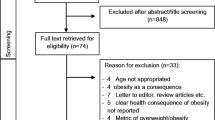Abstract
The Institute of Medicine’s gestational weight gain guidelines are intended to reduce pregnancy complications, poor birth outcomes and excessive postpartum weight retention. The specific weight gain guidelines vary by prepregnancy weight status. We evaluated the validity of prepregnancy weight status (underweight, normal weight, overweight and obesity) classified from self-reported prepregnancy height and weight in reference to those from measured data during the first trimester of pregnancy and imputed data for both pregnant and age-matched non-pregnant women included in the National Health and Nutrition Examination Survey 2003–2006. Self-reported prepregnancy weight status was validated by two ideal references: imputed data with the number of imputations as 10 (n = 5,040) using the data of age-matched non-pregnant women who had both self-reported and measured data, and weight status based on height and weight measured during the first trimester (n = 95). Mean differences, Pearson’s correlations (r), and Kappa statistics (κ) were used to examine the strength of agreement between self-reported data and the two reference measures. Mean (standard error of the mean) differences between self-reported versus imputed prepregnancy weight was −1.7 (0.1) kg with an r = 0.98 (p < 0.001), and κ = 0.78 which indicate substantial agreement for the 504 pregnant women. Mean (SEM) differences between self-reported prepregnancy weight versus measured weight in the first trimester was −2.3 (0.7) kg with r = 0.98 (p < 0.001), and κ = 0.76, which also showed substantial agreements in 95 pregnant women. Prepregnancy weight status classified based on self-reported prepregnancy height and weight was valid.
Similar content being viewed by others
References
Spencer, E. A., Appleby, P. N., Davey, G. K., et al. (2002). Validity of self-reported height and weight in 4808 EPIC-Oxford participants. Public Health Nutrition, 5(4), 561–565.
Lee, D. H., Shin, A., Kim, J., et al. (2011). Validity of self-reported height and weight in a Korean population. Journal of Epidemiology, 21(1), 30–36.
Nyholm, M., Gullberg, B., Merlo, J., et al. (2007). The validity of obesity based on self-reported weight and height: Implications for population studies. Obesity (Silver Spring), 15(1), 197–208.
Yun, S., Zhu, B. P., Black, W., et al. (2006). A comparison of national estimates of obesity prevalence from the behavioral risk factors surveillance system and the National Health and Nutrition Examination Survey. International Journal of Obesity, 30(1), 164–170.
Dahl, A. K., Hassing, L. B., Fransson, E. I., et al. (2010). Agreement between self-reported and measured height, weight, and body mass index in old age: A longitudinal study with 20 years of follow up. Age and Ageing, 39(4), 445–451.
IOM. (2009). Weight gain during pregnancy: Reexamining the guidelines. Washington, DC: The National Academy Press.
Hedderson, M. M., Gunderson, E. P., & Ferrara, A. (2010). Gestational weight gain and risk of gestational diabetes mellitus. Obstetrics and Gynecology, 115(3), 597–604.
Park, S., Sappenfield, W. M., Bish, C., et al. (2011). Reliability and validity of birth certificate prepregnancy weight and height among women enrolled in prenatal WIC program: Florida, 2005. Maternal and Child Health Journal, 15(7), 851–859.
Craig, B. M., & Adams, A. K. (2009). Accuracy of body mass index categories based on self-reported height and weight among women in the United States. Maternal and Child Health Journal, 13(4), 489–496.
Olson, C. M., & Strawderman, M. S. (2003). Modifiable behavioral factors in a biopsychosocial model predict inadequate and excessive gestational weight gain. Journal of American Dietetic Association, 103(1), 48–54.
Cedergren, M. (2006). Effects of gestational weight gain and body mass index on obstetric outcome in Sweden. International Journal of Gynecology & Obstetrics, 93(3), 269–274.
Finer, L. B., & Zolna, M. R. (2011). Unintended pregnancy in the United States: Incidence and disparities, 2006. Contraception, 84(5), 478–485.
Mirel, L. B., Curtin, L. R., Gahche, J. et al. (2009). Characteristics of pregnant women from the 2001–2006 National Health and Nutrition Examination Survey. In: JSM Proceedings GSS, editor. Alexandria, VA: American Statistical Association.
Rubin, D. B. (1987). Multiple imputation for nonresponse in surveys. New York: John Wiley & Sons.
Yuan, Y. C. (2010). Multiple imputation for missing data: Concepts and new development (Version 9.0). Rockville, MD: SAS Institute Inc.
Wayman, J. C. (2003). Multiple imputation for missing data: What is it and how can i use it? In Annual Meeting of the American Educational Research Association, Chicago, IL.
Cohen, J. (1960). A coefficient of agreement for nominal scales. Educational and Psychological Measurement, 20(1), 37–46.
Schafer, J. L. (1997). Analysis of incomplete multivariate data. New York: Chapman and Hall.
Drake, K. M., Longacre, M. R., Dalton, M. A., et al. (2013). Two-method measurement for adolescent obesity epidemiology: Reducing the bias in self-report of height and weight. Journal of Adolescent Health, 53(3), 322–327.
Brunner-Huber, L. R. (2007). Validity of self-reported height and weight in women of reproductive age. Maternal and Child Health Journal, 11(2), 137–144.
Author information
Authors and Affiliations
Corresponding author
Rights and permissions
About this article
Cite this article
Shin, D., Chung, H., Weatherspoon, L. et al. Validity of Prepregnancy Weight Status Estimated from Self-reported Height and Weight. Matern Child Health J 18, 1667–1674 (2014). https://doi.org/10.1007/s10995-013-1407-6
Published:
Issue Date:
DOI: https://doi.org/10.1007/s10995-013-1407-6




